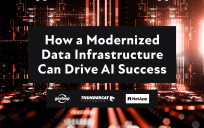State and local governments are obligated to protect the vast amounts of data coming in from a variety of digital sources. As the nation’s record-keepers, these governments must decide how to combine, store, search, and analyze this data. That’s easier said than done.
At GovLoop’s State and Local Tech Trends Virtual Training, we brought together a number of expert speakers and panelists to identify solutions to obstacles that state and local governments face on a day-to-day basis. In the training, You Have Your Data, Now What?, we discussed how best to achieve the maximum impact of data to help drive data driven decisions. The speakers included:
- Michelle Gore, Chief Data Officer, State of Colorado
- Phillip Paz, Senior Sales Engineer, MarkLogic
Agencies aren’t often aware of the data that they have access to, which limits the potential impact state and local governments can create. With so many systems across state governments collecting similar data, a challenge can be identifying the best data. According to Gore, an unwanted result of these slow processes is that people are trying to jump to conclusions faster than the data allows.
In order to find and analyze data in a more efficient manner to make more effective data-driven decisions, Gore identified several steps to find answers.
- Take an inventory of data to determine what information is already in your agencies capacity.
- Identify the business rules and federal mandates that need to be addressed with timelier data.
- Communicate internally and externally with other agencies collecting similar data to identify the most accurate information.
- Create cohesive, aggregated data that eliminates repetitive data.
- Create near real-time reports so that data is timely, available and transparent.
- Unify enterprise-wide data that is available to all agencies within your state and local government to help move government at the speed of business.
With this organized data, MarkLogic’s Phillip Paz discussed the problems of storing and referencing this data in effective matters. The world is continually changing and incommensurable data is a problem. With shrinking budgets, Paz continued to identify low cost options to store data that results in better decisions and faster responses.
As state and local government work to create active and searchable systems for data, Paz advocates for presenting a unified view of structured, semi-structured, and unstructured data across organizational silos. This process includes establishing an Enterprise Data Layer, which consists of data storage, a framework for connecting with remote data sources, and an interface for delivering data to multiple applications. These steps, according to Paz, will provide data operations in state and local government, such as transparent search, discovery, analytics, delivery, and more.
Creating databases of information that can be utilized effectively and transparent are necessary for maximizing impact for best processes and cost-effectiveness. Databases like a NoSQL provide a mechanism for storage and retrieval of data to meet these goals. NoSQL is an option for managing the vast amounts of data that our nation’s record-keepers keep, due to the capacity of massive scale collection of structured and unstructured data. The results, says Paz, are faster time to receive accurate results at a fraction of the cost of unorganized data.
Erasing the need for government to waste valuable budgetary resources and time on deciphering under-analyzed data. Managing data utilizing the Enterprise Data Layer and database services, such as NoSQL, offer numerous benefits that give state and local governments that ability to make better decisions and faster responses. This will also occur at a lower cost, reduce development cycles of data, reduce administrative overhead, and raise performance and scalability standards. When your government understands the data it has access to, it can work at the speed of business.
If you would like to learn more about how state and local governments can better understand the data they have access to, you can check out GovLoop’s State and Local Tech Trends Virtual Training on-demand.





Leave a Reply
You must be logged in to post a comment.